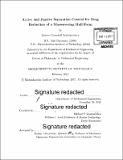Active and passive separation control for drag reduction of a maneuvering hull form
Author(s)
Schulmeister, James Crandall
DownloadFull printable version (24.99Mb)
Other Contributors
Massachusetts Institute of Technology. Department of Mechanical Engineering.
Advisor
Michael S Triantafyllou.
Terms of use
Metadata
Show full item recordAbstract
Boundary layer separation is a source of large fluid dynamic forces on many engineered vehicles and structures, limiting the speed and efficiency at which we transport people and goods. The maneuvering of ocean and air vehicles in particular is limited by resistance due to cross-flow separation. Hull forms with lower hydrodynamic resistance in maneuvers are able to follow trajectories with tighter turns and at higher speeds. Despite the progress that has been made in the control of two dimensional flow separation, little has been done to apply flow control to complex three-dimensional separation from maneuvering hull forms. This thesis studies and develops mechanisms for mitigating three-dimensional cross-flow separation to reduce the drag of hull forms in maneuvers. A new strategy is proposed for designing flow control mechanisms for the three dimensional flow past maneuvering hull forms based on the unsteady cross-flow analogy. The unsteady cross-flow analogy relates the steady flow past a three-dimensional body to an analogous unsteady two-dimensional flow past a cylinder that changes size and shape in time. This provides a framework for adapting two-dimensional drag reduction techniques to the three-dimensional flow. In addition, the unsteady cross-flow analogy is computationally inexpensive and so is suitable for iterative use in preliminary design. The new strategy is considered by first implementing the unsteady cross-flow analogy in numerical simulations. Next, passive and active flow control mechanisms are studied experimentally for drag reduction of a circular cylinder and then adapted through the analogy for drag reduction of a slender body at an angle of attack. Passive control is exerted through modifications to the shape of the body and active control is exerted with rotating control cylinders. Both passive and active methods are experimentally demonstrated to reduce the drag. The experimental results also confirm key predictions of the unsteady cross-flow analogy, demonstrating that it is a promising tool for developing three-dimensional separation control techniques.
Description
Thesis: Ph. D., Massachusetts Institute of Technology, Department of Mechanical Engineering, 2017. Cataloged from PDF version of thesis. Includes bibliographical references (pages 205-212).
Date issued
2017Department
Massachusetts Institute of Technology. Department of Mechanical EngineeringPublisher
Massachusetts Institute of Technology
Keywords
Mechanical Engineering.